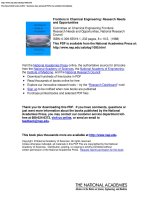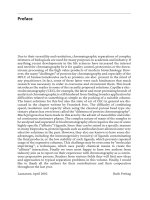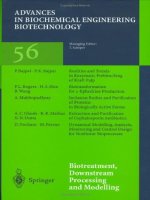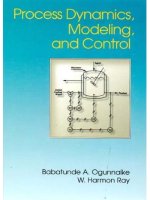ADVANCES IN CHEMICAL ENGINEERING pptx
Bạn đang xem bản rút gọn của tài liệu. Xem và tải ngay bản đầy đủ của tài liệu tại đây (21.77 MB, 594 trang )
ADVANCES IN
CHEMICAL ENGINEERING
Edited by Zeeshan Nawaz and Shahid Naveed
Advances in Chemical Engineering
Edited by Zeeshan Nawaz and Shahid Naveed
Published by InTech
Janeza Trdine 9, 51000 Rijeka, Croatia
Copyright © 2012 InTech
All chapters are Open Access distributed under the Creative Commons Attribution 3.0
license, which allows users to download, copy and build upon published articles even for
commercial purposes, as long as the author and publisher are properly credited, which
ensures maximum dissemination and a wider impact of our publications. After this work
has been published by InTech, authors have the right to republish it, in whole or part, in
any publication of which they are the author, and to make other personal use of the
work. Any republication, referencing or personal use of the work must explicitly identify
the original source.
As for readers, this license allows users to download, copy and build upon published
chapters even for commercial purposes, as long as the author and publisher are properly
credited, which ensures maximum dissemination and a wider impact of our publications.
Notice
Statements and opinions expressed in the chapters are these of the individual contributors
and not necessarily those of the editors or publisher. No responsibility is accepted for the
accuracy of information contained in the published chapters. The publisher assumes no
responsibility for any damage or injury to persons or property arising out of the use of any
materials, instructions, methods or ideas contained in the book.
Publishing Process Manager Bojan Rafaj
Technical Editor Teodora Smiljanic
Cover Designer InTech Design Team
First published March, 2012
Printed in Croatia
A free online edition of this book is available at www.intechopen.com
Additional hard copies can be obtained from
Advances in Chemical Engineering, Edited by Zeeshan Nawaz and Shahid Naveed
p. cm.
ISBN 978-953-51-0392-9
Contents
Preface IX
Part 1 Fundamentals 1
Chapter 1 Application of Chebyshev Polynomials to
Calculate Density and Fugacity Using SAFT Equation
of State to Predict Asphaltene Precipitation Conditions 3
Seyyed Alireza Tabatabaei-Nejad and Elnaz Khodapanah
Chapter 2 Based on Common Inverted Microscope
to Measure UV-VIS Spectra of Single
Oil-Gas Inclusions and Colour Analysis 43
Ailing Yang
Chapter 3 Challenging Evaluation of the
Hybrid Technique of Chemical Engineering –
Proton NMR Technique for Food Engineering 69
Yasuyuki Konishi and Masayoshi Kobayashi
Chapter 4 Modelling Approach for
Redesign of Technical Processes 93
Ivan Lopez-Arevalo, Victor Sosa-Sosa
and Saul Lopez-Arevalo
Chapter 5 Application Potential of Food Protein Modification 135
Harmen H.J. de Jongh and Kerensa Broersen
Part 2 Catalysis and Reaction Engineering 183
Chapter 6 Rational Asymmetric Catalyst
Design, Intensification and Modeling 185
Zeeshan Nawaz, Faisal Baksh,
Ramzan Naveed and Abdullah Alqahtani
Chapter 7 Preparation, Catalytic Properties and
Recycling Capabilities Jacobsen’s Catalyst 203
Jairo Cubillos
VI Contents
Chapter 8 Carbohydrate-Based Surfactants:
Structure-Activity Relationships 215
Hary Razafindralambo, Christophe Blecker
and Michel Paquot
Chapter 9 CO
2
Biomitigation and Biofuel Production
Using Microalgae: Photobioreactors
Developments and Future Directions 229
Hussein Znad, Gita Naderi,
H.M. Ang and M.O. Tade
Chapter 10 Production of Biodiesel from Microalgae 245
Marc Veillette, Mostafa Chamoumi, Josiane Nikiema,
Nathalie Faucheux and Michèle Heitz
Chapter 11 Sulfonation/Sulfation Processing
Technology for Anionic Surfactant Manufacture 269
Jesús Alfonso Torres Ortega
Chapter 12 Pollutant Formation in Combustion Processes 295
Grzegorz Wielgosiński
Part 3 Process Engineering 325
Chapter 13 Systematic Framework for Multiobjective
Optimization in Chemical Process Plant Design 327
Ramzan Naveed, Zeeshan Nawaz,
Werner Witt and Shahid Naveed
Chapter 14 CFD Modelling of Fluidized
Bed with Immersed Tubes 357
A.M.S. Costa, F.C. Colman,
P.R. Paraiso and L.M.M. Jorge
Chapter 15 Optimal Synthesis of Multi-Effect
Evaporation Systems of Solutions
with a High Boiling Point Rise 379
Jaime Alfonzo Irahola
Chapter 16 Optimization of Spouted Bed Scale-Up
by Square-Based Multiple Unit Design 405
Giorgio Rovero, Massimo Curti and Giuliano Cavaglià
Chapter 17 Techno-Economic Evaluation of Large Scale
2.5-Dimethylfuran Production from Fructose 435
Fábio de Ávila Rodrigues and Reginaldo Guirardello
Chapter 18 Inland Desalination: Potentials and Challenges 449
Khaled Elsaid, Nasr Bensalah and Ahmed Abdel-Wahab
Contents VII
Part 4 Separation Technology 481
Chapter 19 Phase Diagrams in Chemical Engineering:
Application to Distillation and Solvent Extraction 483
Christophe Coquelet and Deresh Ramjugernath
Chapter 20 Organic/Inorganic Nanocomposite
Membranes Development for Low
Temperature Fuel Cell Applications 505
Touhami Mokrani
Chapter 21 Membrane Operations for Industrial Applications 543
Maria Giovanna Buonomenna,
Giovanni Golemme and Enrico Perrotta
Chapter 22 Thermal Study on Phase Transitions of
Block Copolymers by Mesoscopic Simulation 563
César Soto-Figueroa, Luis Vicente
and María del Rosario Rodríguez-Hidalgo
Preface
This book addresses the evolutionary stage of Chemical Engineering and provides an
overview to the state of the art and technological advancements. Chemical
Engineering applications have always been challenging. Optimization of plausible
solutions to problems in economic manner through technology is worth. The script has
been designed to enable the reader to access the desired knowledge on fundamentals
and advancements in Chemical Engineering in a single text. The molecular perspective
of Chemical Engineering is increasingly becoming important in the refinement of
kinetic and thermodynamic molding. As a result many of the theories, subject matters
and approaches are being revisited and improved. The approach to industrial
problems has been reviewed with modern trend in technology.
The subject of primary interest in this text is to highlight recent advances in chemical
engineering knowledge. Therefore, the book is divided into four section fundamentals,
catalysis & reaction engineering, process engineering and separation technology.
Fundamentals covers, application of chebyshev polynomials to analyze soft equation of
state, UV-VIS Spectra analysis, proton NMR technique applications, and modeling
approach for process redesign. Catalysis and reaction engineering discusses; asymmetric
catalyst design, intensification, modeling, prepration, characterization and recycling,
carbohydrate-based surfactants, bio-fuel production form micro-algae, biodiesel using
triglycerides, and pollutant formation during combustion. Third section of process
engineering focused on systematic multiobjective process optimization, CFD modeling
of fluidized bed, optimization of evaporation system, spouted bed scale-up, desalination,
and economic evaluation of macro scale production processes. Last section of the book
has emphasized on separation technology includes phase diagram analysis, membranes
developments and applications, and phase transitions study. Molecular chemistry,
reaction engineering and modeling have been demonstrated to be interrelated and of
value for practical applications. A rational and robust industrial design can be conceived
with this understanding. The book can be of interest for undergraduate, graduate and
professionals for a number of reasons besides the incorporation of innovation in the text.
Dr. Zeeshan Nawaz
SABIC Technology and Innovation,
Saudi Basic Industries Corporation,
Riyadh
Kin
g
dom of Saudi Arabia
Prof. Dr. Shahid Naveed
Department of Chemical Engineering,
University of Engineering and Technology,
Lahore
Pakistan
Part 1
Fundamentals
1
Application of Chebyshev
Polynomials to Calculate Density and
Fugacity Using SAFT Equation of State to
Predict Asphaltene Precipitation Conditions
Seyyed Alireza Tabatabaei-Nejad and Elnaz Khodapanah
Chemical Engineering Department, Sahand University of Technology, Tabriz
Iran
1. Introduction
Equations of state are the essential tools to model physical and chemical processes in which
fluids are involved. The majority of PVT calculations carried out for oil and gas mixtures are
based on a cubic equation of state (EoS). This type of equations dates back more than a
century to the famous Van der Waals equation (Van der Waals, 1873). The cubic equations of
state most commonly used in the petroleum industry today are very similar to the Van der
Waals equation, but it took almost a century for the petroleum industry to accept this type
of equation as a valuable engineering tool. The Redlich and Kwong EoS (Redlich & Kwong,
1949) was modified from the VdW with a different attractive term, the repulsive term being
the same. Since 1949 when Redlich and Kwong (RK) formulated their two-parameter cubic
EoS, many investigators have introduced various modifications to improve ability of RK-
EoS. Two other well-known cubic equations are Soave-Redlich-Kwong (SRK), (Soave, 1972)
and Peng-Robinson (PR) (Peng & Robinson, 1976) equations which have different
formulation of the attractive term and are popular in the oil industry in the thermodynamic
modeling of hydrocarbon fluids.
There are thousands of cubic equations of states, and many noncubic equations. The
noncubic equations such as the Benedict-Webb-Rubin equation (Benedict et al., 1942), and its
modification by Starling (Starling, 1973) have a large number of constants; they describe
accurately the volumetric behavior of pure substances. But for hydrocarbon mixtures and
crude oils, because of mixing rule complexities, they may not be suitable (Katz &
Firoozabadi, 1978). Cubic equations with more than two constants also may not improve the
volumetric behavior prediction of complex reservoir fluids. In fact, most of the cubic
equations have the same accuracy for phase behavior prediction of complex hydrocarbon
systems; the simpler often do better (Firoozabadi, 1999).
Hydrocarbons and other non-polar fluid vapor–liquid equilibrium properties can be
satisfactorily modeled using a symmetric approach to model both, the vapor and the liquid
phase fugacity with the use of a Van der Waals type equation model (Segura et al., 2008), the
Soave–Redlich–Kwong or Peng–Robinson equations being the most popular ones. When
Advances in Chemical Engineering
4
polar fluids are involved at moderate pressures, activity coefficient models are more suitable
for modeling the liquid phase. When a higher pressure range is also a concern, a symmetric
EoS approach with complex mixing rules including an excess Gibbs energy term from an
activity coefficient model can provide good results. Unfortunately, even those approaches
show limitations for complex fluids and can drastically fail near the critical region, unless a
specific treatment is included (Llovell et al., 2004, 2008).
Since the early 1980's, there has been increased interest in developing an EoS for pure fluids
and mixtures of large polyatomic molecules that does not rely on a lattice description of
molecular configurations. A rigorous statistical-mechanical theory for large polyatomic
molecules in continuous space is difficult because of their asymmetric structure, large
number of internal degrees of freedom, and strong coupling between intra- and
intermolecular interactions. Nevertheless, a relatively simple model represents chain-like as
freely joined tangent hard spheres (Chapman et al., 1984; Song et al., 1994; Wertheim, 1984).
A hard-sphere-chain (HSC) EoS can be used as the reference system in place of the hard-
sphere reference used in most existing equations of state for simple fluids. Despite their
simplicity, hard-sphere-chain models take into account some significant features of real
fluids containing chain-like molecules including excluded volume effects and chain
connectivity. To describe the properties of fluids consisting of large polyatomic molecules, it
is necessary to introduce attractive forces by adding a perturbation to a HSC EoS. Assuming
that the influence of attractive forces on fluid structure is week, a Van der Waals type or
other mean-field term (e.g. square-well fluids) is usually used to add attractive forces to the
reference hard-sphere-chain EoS (Prausnitz & Tavares, 2004).
Molecular-based equations of state, also routed in statistical mechanics, retain their interest
in chemical engineering calculations as they apply to a wide spectrum of thermodynamic
conditions and compounds, being computationally much less demanding than molecular
simulations. Among them, the Statistical Associating Fluid Theory (SAFT) EoS has become
very popular because of its capability of predicting thermodynamics properties of several
complex fluids, including chain, aromatic and chlorinated hydrocarbons, esters alkanols,
carboxylic acids, etc. (Huang & Radosz, 1990). SAFT was envisioned as an application of
Wertheim’s theory of association (Wertheim, 1984, 1986) through the use of a first-order
thermodynamic perturbation theory (TPT) to formulate a physically based EoS (Chapman et
al., 1990; Huang & Radosz, 1991). The ambition of making SAFT an accurate equation for
engineering purposes has promoted the development of different versions that tried to
overcome the limitations of the original one (Economou, 2002; Muller & Gubbins, 1995).
SAFT has a similar form to group contribution theories in that the fluid of interest is initially
considered to be a mixture of unconnected groups or segments. SAFT includes a chain
connectivity term to account for the bonding of various groups to form polymers and an
explicit intermolecular hydrogen bonding term. A theory based in statistical mechanics
offers several advantages. The first advantage is that each of the approximations made in
the development of SAFT has been tested versus molecular simulation results. In this way,
the range of applicability of each term in the EoS has been determined. The second
advantage is that the EoS can be systematically refined. Since any weak approximations in
SAFT can be identified, improvement is made upon the EoS by making better
approximations or by extending the theory. Like most thermodynamic models, SAFT
approaches require the evaluation of several parameters relating the model to the
Application of Chebyshev Polynomials to Calculate Density and
Fugacity Using SAFT Equation of State to Predict Asphaltene Precipitation Conditions
5
experimental system. A third advantage of SAFT-type equations versus other approaches is
that, as they are based on statistical mechanics, parameters have a clear physical meaning;
when carefully fitted they can be used with predictive power to explore other regions of the
phase diagram far from the data and operating conditions used in the parameter regression,
performing better than other models for interacting compounds like activity coefficient
models (Prausnitz et al., 1999). In SAFT a chain molecule is characterized by the diameter or
volume of a segment, the number of segments in the chain, and the segment–segment
dispersion energy. For an associating or hydrogen bonding molecule, two more physical
parameters are necessary: the association energy related to the change in enthalpy of
association and the bond volume related to the change in entropy on association. The SAFT
equation has found some impressive engineering applications on those fluids with chain
bonding and hydrogen bonding (Chapman et al., 2004).
Asphaltenes are operationally defined as the portion of crude oil insoluble in light normal
alkanes (e.g., n-heptane or n-pentane), but soluble in aromatic solvents (e.g., benzene or
toluene). This solubility class definition of asphaltenes suggests a broad distribution of
asphaltene molecular structures that vary greatly among crude sources. In general,
asphaltenes possess fused ring aromaticity, small aliphatic side chains, and polar
heteroatom-containing functional groups capable of donating or accepting protons inter-
and intra-molecularly. Although asphaltene fractions can be complex molecular species
mixtures, they convey, as a whole, an obvious chemical similarity, irrespective of crude
geographic origin (Ting, 2003). Asphaltene stability depends on a number of factors
including pressure, temperature, and compositions of the fluid; the latter incorporates the
addition of light gases, solvents and other oils commingled operation or charges due to
contamination. During pressure depletion at constant temperature, asphaltene aggregate
formation is observed within a range above and below the bubble point. As pressure drops
during production from the reservoir pressure, asphaltene precipitatin can appear due to
changes in the solubility of asphaltene in crude oil. The maximum asphaltene precipitation
occurs at or around the bubble point pressure. Below the bubble point light gases come out
of the solution increasing the asphaltene solubility again (Ting, 2003). Temperature changes
also affect asphaltene precipitation, For hydrocarbons deposited in shallow structure, the
wellhead flowing temperatures are typically not excessive, 110-140
°
F. However, sea bottom
temperature in deep water is cold, often near or below 40
°
F, even in equatorial waters.
Cooling of flow streams during transportation can lead to asphaltene precipitation (Huang
& Radosz, 1991). Increases in temperature at constant pressure normally stabilize the
asphaltene in crude oil. Depending on the composition of the oil, it is possible to find cases
where precipitation first decreases and then increases with increasing temperature (Verdier
et al., 2006). Also, depending on the temperature level, significant temperature effects can be
observed (Buenrostro-Gonzales & Lira-Galeana, 2004). Changes in composition occur
during gas injection processes employed in Enhanced Oil Recovery (EOR). Gas injection
includes processes such as miscible flooding with CO
2
, N
2
or natural gas or artificial gas
lifting. The dissolved gas decreases asphaltene solubility and the asphaltene becomes more
unstable (Verdier et al., 2006).
The tendency of petroleum asphaltenes to associate in solution and adsorb at interfaces can
cause significant problems during the production, recovery, pipeline transportation, and
refining of crude oil. Therefore, it is necessary to predict the conditions where precipitation
Advances in Chemical Engineering
6
occurs and the amount of precipitate. The approach we have taken here to model is to use
the SAFT EoS, as it explicitly builds on the association interaction and the chain connectivity
term to account for the bonding of various groups. Therefore, the equation is able to provide
insights on the asphaltene precipitation behavior. By some algebraic manipulations on this
equation, we derive a simplified form of the compressibility factor or pressure as a function
of density. Due to pressure explicit form of the SAFT EoS, an approximation technique
based on Chebyshev polynomials to calculate density and hence fugacity requisite to
perform phase equilibrium calculations is applied. To demonstrate the ability of SAFT EoS a
binary system composed of ethanol and toluene is tested. Applying Chebysheve polynomial
approximation, density is calculated for the above system at different temperatures in a
range of 283.15 K to 353.15 K and for pressures up to 45 MPa. Evaluating fugacity is a
necessary step in phase equilibrium calculations. Hence, fugacity is derived using SAFT
EoS. Then the model is used to predict phase behavior of oil-asphaltene systems.
2. Formulation of the problem
2.1 SAFT equation of state
The statistical association fluid theory (SAFT) (Chapman et al., 1990) is based on the first
order perturbation theory of Wertheim (Wertheim, 1987). The essence of this theory is that
the residual Helmholtz energy is given by a sum of expressions to account not only for the
effects of short-range repulsions and long-range dispersion forces but also for two other
effects : chemically bonded aggregation (e.g. formation of chemically stable chains) and
association and/or solvation (e.g. hydrogen bonding) between different molecules (or
chains). For a pure component a three step process for formation of stable aggregates (e.g.
chains) and subsequent association of these aggregates is shown in figure 1. Initially, a fluid
consists of equal-sized, single hard spheres. Intermolecular attractive forces are added
Fig. 1. Three steps to form chain molecules and association complexes from hard spheres in
the SAFT model (Prausnitz et al., 1999).
Application of Chebyshev Polynomials to Calculate Density and
Fugacity Using SAFT Equation of State to Predict Asphaltene Precipitation Conditions
7
which are described by an appropriate potential function, such as the square-well potential.
Next, each sphere is given one, two or more “sticky spots”, such that the spheres can stick
together (covalent bonding) to form dimmers, trimers and higher stable aggregates as
chains. Finally, specific interaction sites are introduced at some position in the chain to form
association complex through some attractive interaction (e.g. hydrogen bonding). Each step
provides a contribution to the Helmholtz energy.
Using SAFT EoS, the residual molar Helmholtz energy
contributes from formation of
hard spheres, chains, dispersion (attraction), and association which would be in the form of:
=
+
+
+
(1)
Here the sum of the first two terms is the hard-sphere-chain reference system accounting for
molecular repulsion and chain connectivity (chemical bonding); the sum of the last two
terms is the perturbation accounting for molecular attraction and for association due to
specific interactions like hydrogen bonding. Application of the relation between molar
Helmholtz energy, , and the equation of state, gives the SAFT EoS for pure fluids
(Prausnitz et al., 1999). We can write for compressibility factor of a real fluid:
=
=
+
+
+
+
(2)
with
=1.0 and for mixtures,
=
6
ξ
ξ
1−ξ
+
3ξ
ξ
(1−ξ
)
+
(3−ξ
)ξ
(1−ξ
)
(3)
With
ξ
=
6
(
)
=0,1,2,3
(4)
=
1−0.12
(
−3
⁄)
(5)
=
ℎ
+ℎ
+ℎ
1+ℎ
+ℎ
+ℎ
(6)
here is the total molar density,
, is the mole fraction of component ,
is the number of
segments per molecule , and
is the temperature dependent segment diameter. The
parameters ,
, ,
and
are temperature, Avogadro's and Boltzmann's constants,
segment energy and diameter, respectively. By simple algebraic manipulation on Eq. (3) , we
arrive at the following simplified form of the hard sphere term:
where,
Advances in Chemical Engineering
8
ℎ
=
(
̅
+3
)
(7)
ℎ
=
(
−2̅
−3
+3
)
(8)
ℎ
=
(
̅
−
)
(9)
ℎ
=−3
(10)
ℎ
=3
(11)
ℎ
=−
(12)
The parameters used in Eqs. (7) – (12) are defined as the following:
̅
=
(13)
=
(14)
=
(15)
=
(16)
=
6
(17)
The contribution accounting for the formation of chain molecules of the various components
in the mixture is
=
(
1−
)
(
)
(18)
(
)
=
2ξ
+3
ξ
−4ξ
+2
ξ
+2ξ
+
ξ
ξ
−3
ξ
ξ
1−ξ
2−4ξ
+3
ξ
+2ξ
+
ξ
−3
ξ
ξ
(19)
where ξ
(=2,3) is given by Eq. (4). It is remarkable that no mixing rules are necessary in
Eq. (3) and (18). After some arithmetic operations on Eq. (18), the following simplified
density dependent equation for the chain term of SAFT EoS is presented as:
Application of Chebyshev Polynomials to Calculate Density and
Fugacity Using SAFT Equation of State to Predict Asphaltene Precipitation Conditions
9
=
(
1−
)
ℎ
(
)
+ℎ
(
)
+ℎ
(
)
2+ℎ
(
)
+ℎ
(
)
+ℎ
(
)
+ℎ
(
)
(20)
where,
ℎ
(
)
=
2
+3
(21)
ℎ
(
)
=−4
+2
(22)
ℎ
(
)
=
+2
−3
(23)
ℎ
(
)
=
−6
+3
(24)
ℎ
(
)
=6
+
−9
(25)
ℎ
(
)
=9
−2
−
(26)
ℎ
(
)
=
−3
(27)
SAFT uses the following expression for the dispersion contribution to the compressibility
factor (Pedersen & Christensen, 2007):
=−2
ξ
ξ
−
̅
ξ
ξ
+
ξ
(28)
where
=1+
̅
8ξ
−2ξ
1−ξ
+
(
1−
̅
)
20ξ
−27ξ
+12ξ
−2ξ
1−ξ
2−ξ
(29)
=−
̅
−4ξ
+20ξ
+8
1−ξ
+
(
1−
̅
)
2ξ
+12ξ
−48ξ
+40
1−ξ
2−ξ
(30)
=
(31)
=
(32)
Advances in Chemical Engineering
10
=
(
̅
)
ξ
(33)
=
(
̅
)
ξ
(34)
In equations (31) and (32):
=
1−
(35)
=
1
2
+
(36)
where
is a binary interaction parameter similar to that in the mixing rule for the -
parameter of a cubic EoS (Pedersen & Christensen, 2007). In equationa (33) and (34):
(
̅
)
=
+
̅
−1
̅
+
̅
−1
̅
.
̅
−2
̅
, =0,1,…,6
(37)
(
̅
)
=
+
̅
−1
̅
+
̅
−1
̅
.
̅
−2
̅
, =0,1,…,6
(38)
The universal constants for
,
,
,
,
and
are given in Table 1.
J
0 0.9105631 - 0.3084017 -0.0906148 0.7240947 0.5755498 0.0976883
1 0.6361281 0.1860531 0.4527843 2.2382792 0.6995095 -0.2557575
2 2.6861348 -2.5030047 0.5962701 -4.0025849 3.8925674 -9.1558561
3 -26.547362 21.419793 -1.7241829 -21.003577 -17.215472 20.642076
4 97.759209 -65.255885 -4.1302112 26.855641 192.67226 -38.804430
5 -159.59154 83.318680 13.776632 206.55134 -161.82646 93.626774
6 91.297774 -33.746923 -8.6728470 -355.60235 -165.20769 -29.666905
Table 1. The universal constants for a
, a
, a
, b
, b
and b
parameters used in SAFT
EoS (Pedersen & Christensen, 2007).
Again, simplification of Eq. (28), would yield the following density dependent form of the
dispersion term in SAFT EoS:
Application of Chebyshev Polynomials to Calculate Density and
Fugacity Using SAFT Equation of State to Predict Asphaltene Precipitation Conditions
11
234567
1234567 2
234567
123456
23 4 5 6
78 9 10 11 12
0
. . . . .6.
4. . . . . .
disp na
ZdIdIdIdIdIdIdI PrAdisp
disp disp disp disp disp disp
disp disp disp disp disp disp
bd
23456 2
8 9 10 11 12 13 3
2
23456
12 3 4 5 6
23 4 5 6
78 9 10 11 12
2
13 14 15
. . . .
1
4
na
IdI dI dI dI dI PS
disp disp disp disp disp disp
disp disp disp disp disp disp
disp disp disp d
345
16 17 18
2345678
19 20 21 22 23 24 25 26
23456
01 2 3 4 5 6
8
isp disp disp
disp disp disp disp disp disp disp disp
b Idisp Idisp Idisp Idisp Idisp Idisp
where the parameters used in the equation are given below,
=4
(
3̅−4
)
(40)
=
(
27̅−6
)
(41)
=
(
82−70̅
)
(42)
=
(
51̅−52
)
(43)
=16
(
1−̅
)
(44)
=2
(
̅−1
)
(45)
=−20
(46)
=41
(47)
=−44
(48)
=26
(49)
=−8
(50)
=
(51)
=40+24̅ (52)
=
(
192̅−128
)
(53)
=
(
148−372̅
)
(54)
=
(
230̅−70
)
(55)
=
(
8−52̅
)
(56)
(39)
Advances in Chemical Engineering
12
=
(
2+2̅
)
(57)
=−52
(58)
=146
(59)
=−231
(60)
=225
(61)
=−138
(62)
=52
(63)
=−11
(64)
=
(65)
=
(66)
=
(67)
=
(68)
=
(69)
=
(70)
=
(71)
=2
(72)
=3
(73)
=4
(74)
=5
(75)
=6
(76)
=7
(77)
=−12
.
.
(78)
=−12
.
.
(79)
=−12
.
.
(80)
=−12
.
.
(81)
=−12
.
.
(82)
Application of Chebyshev Polynomials to Calculate Density and
Fugacity Using SAFT Equation of State to Predict Asphaltene Precipitation Conditions
13
=−12
.
.
(83)
=−12
.
.
(84)
=2
(85)
=3
(86)
=4
(87)
=5
(88)
=6
(89)
=7
(90)
=
=
⁄
(91)
=
=
⁄
(92)
Similarly,
can be derived rigorously from statistical mechanics (Chapman et al., 1990).
The relation is a mole fraction average of the corresponding pure-component equations:
=
1
−
1
2
(93)
where
, the mole fraction of component i in the mixture not bonded with other
components at site
S , is given by:
=1+
(94)
with
=
1
1−ξ
+
3
+
ξ
1−ξ
+2
+
ξ
1−ξ
−1
(95)
In Eq. (94), summation
∑
is over all specific interaction sites on molecule and summation
∑
is over all
components. The association/salvation
and the dimensionless
Advances in Chemical Engineering
14
parameter
characterize, respectively, the association
(
=
)
and solvation
(
≠
)
energy and volume for the specific interaction between sites
and . These parameters are
adjustable. Equation (93) requires no mixing rules. As it can be seen in Eq. (94),
’
s satisfy
a non-linear system of equations which can be solved using any iterative technique such as
Gauss-Seidel, Successive-Over-Relaxation (SOR) or Jacobi iterative method. The derivative
of the function
with respect to yields the following equation:
11
2
1
cc
jj
i
jj
i
j
c
j
j
NN
YY
ij
jij j
S
jY jY
S
A
Y
N
Y
jij
jY
W
zX W z X
X
XN
X
zWX
(96)
where,
223
33
2
3332
2
34
2
3
2
2332
1
3
ξξ
ξ
1 ξ 1 ξ 21 ξξ
ξ
ξ
22ξ 1 ξ 31 ξξ
ij
ij
SY
SY
ij
ij
ij
ij
ij
ij
W
kexp
kT
dd
dd
dd
dd
(97)
As it can be seen from Eq. (96),
(
⁄)
’s are solutions of a linear system of equations
which can be estimated using a known technique such as Gaussian Elimination, Gauss-
Jordan or Least Square method (Burden et al., 1981).
2.2 Derivation of fugacity using SAFT EoS
The fugacity of component i in terms of independent variables V and T is given by the
following equation for a given phase (Danesh , 1998; Prausnitz et al., 1999; Tabatabaei-
Nejad, & Khodapanah, 2009):
, ,
1,2, , ,
jk
k
k
k
k
TVn
V
c
RTln
f
PRT
RTln dV RTlnZ
nV
zP
kNLV
(98)
where
,
,
, V , Z and are fugacity, fugacity coefficient and the number of moles of
component k , volume, compressibility factor, and pressure, respectively. The superscript
denotes liquid (L) and vapor phases (V).
The compressibility factor is related to the volume by the following equations:
Application of Chebyshev Polynomials to Calculate Density and
Fugacity Using SAFT Equation of State to Predict Asphaltene Precipitation Conditions
15
=
(99)
=
(100)
where
refers to the total number of moles of the known phase.
To use equation (98), we require a suitable EoS that holds for the entire range of possible
mole fractions z at the system temperature and for the density range between 0 and
.
Application of the SAFT EoS in Eq. (98) yields the following equation for calculating the
fugacity of the components:
, , , ,
, ,
, ,
1,2, ,
jk jk
jk
jk
hs ch
k
kk
VV
TVn TVn
disp
assoc
kk
VV
TVn
TVn
c
nZ nZ
RT RT
RTln Z dV dV
Vn Vn
nZ
nZ
RT RT
dV dV
Vn V n
kN
(101)
The following equations are derived for the first term in Eq. (101) accounting for the hard
sphere contribution of SAFT:
0
, , , ,
_
1,2, ,
jk jk
hs hs
kk
V
TVn TVn
c
nZ nZ
RT RT
IR HS dV d
Vn n
kN
(102)
23
11 22 33
, ,
12
23 23
45 6 45 6
2323
44 5 5 6 6 1 2 3
2. 3. 4.
1. . . 1. . .
.2. 3
jk
hs
kk k
k
TVn
kk k
nZ
hs hs hs hs hs hs
n
hs hs hs hs hs hs
hs hs hs hs hs hs hs hs hs
(103)
The parameters used in Eq. (103) are given by equations (7) – (17) and the following
equations:
1331212
33
kk k k kna
hs r S rS S S S S P
(104)
ℎ
=
(
−2̅
−4̅
−3
−3
−3
+9
)
(105)
ℎ
=
(
̅
+3̅
−3
−
)
(106)
ℎ
=−3
(107)









